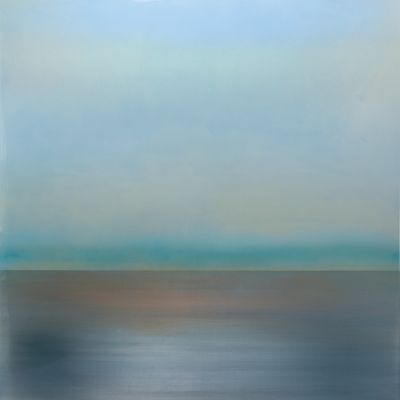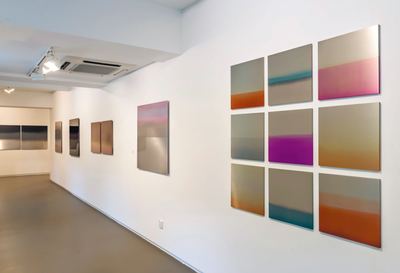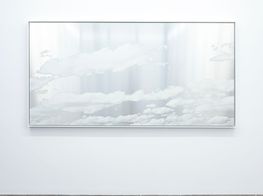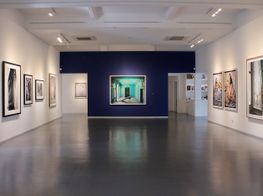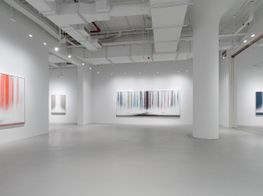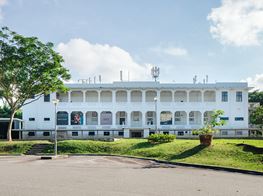Miya Ando: Traversing the Edge of a Forest
IN PARTNERSHIP WITH GILLMAN BARRACKS
Born to a Japanese mother and an American father, Miya Ando is very much a creature of both the East and West. Known for creating large-scale installations, paintings and sculptures redolent of natural phenomena, as a child she split her time between the redwood forests of Santa Cruz, California, and a Buddhist temple in Okayama, Japan, where her grandfather served as a priest. 'Both places had an equal influence on me, I think', she told me in her studio in New York, where we met one hot summer day. 'There's this Venn diagram where the two circles meet, and in that area is my practice.'
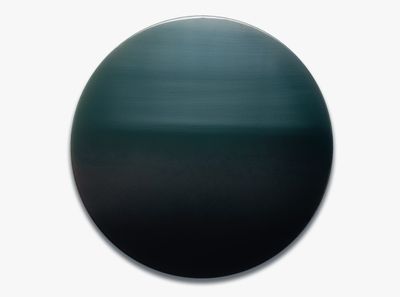
Miya Ando, Blue Rust Brown Mandala (2017). Dye, pigment, resin and urethane on stainless steel. 91.4 cm. Courtesy Sundaram Tagore Gallery, Hong Kong/New York/Singapore.
Ando is slight, and speaks of her work exuberantly, running from corner to corner of her loft-like studio to show me what she is working on. There are sculptures made from thick pieces of glass which, when observed closely, reveal textures reminiscent of the ocean and clouds. There are her mandalas, created out of leaves soaked in bleach so that their cellulose filaments dissipate, leaving behind only their veins. There are photographs of the redwood forest printed on panels of silk chiffon, and pieces of wood that have been coated in silver nitrate to reveal the intricacies of their crevasses. Her well-known paintings on metal, which resemble the ocean at dusk and dawn, cover two walls, imparting a deep sense of calm. And there is a photograph of her grandfather, whose reverence for metal she inherited—Ando comes from an ancient lineage of sword-makers.
How do you traverse the Eastern and Western influences in both your life and your work? How do they influence the materials you choose?
I'm a 16th-generation sword-maker. Our family made swords, and then became Buddhist priests. A lot of swordsmiths became Buddhist priests because it's already a somewhat religious pursuit. My great-uncles still have our family's swords. I've only seen them a few times, which is all you really need because they are really intense. They are the apex of so many things—craftsmanship, refinement, purpose, usage. My uncles will say, 'I need to take out the other [sword] so he can sit next to his brother.' The swords are not sentient, but—it's difficult, I don't have the words. They are not mundane. They have been activated in some way. [Ando turns and picks up a tree stump that has been coated in silver nitrate.] I'm interested in elements that harmonise or are based in alchemy. Meaning, one object or element that transmogrifies into something else—or maybe it becomes both things. This sculpture is metal or wood. Maybe it's both. Maybe it's neither. I'm fascinated with the perception of things. [She takes out one of the leaves she uses to create her mandalas, which she intends to use to create a forest-like installation.]
Right now, I'm working on a piece based on the oldest written narrative in Japan. It's from the 10th century, the Heian period, and it's such a sweet story. This elderly bamboo cutter goes into the forest every day. One day he cuts open a piece of bamboo, and there's a baby girl inside. She is tiny, three inches tall, and luminous. Her name is the Moon Princess. She grows up and she's so beautiful. But she has to go back to the moon, where she is from. The emperor of Japan writes her a letter saying, 'Please come back', and then he burns it. The smoke rising from Mount Fuji is his letter to her.
In the story, the forest is a bounty, dreams are answered, and everything is magic. There is love there. Juxtaposed with the Western archetype of the forest, which is darker, ominous and savage, it creates an edge. When I create a forest in my work, I'm traversing an edge. There's this idea that there are different perceptions going on which are very distinctive. Maybe it's related to this idea of thinking in terms of a Buddhist mandala. Mandalas have been used for meditation and spiritual transformation. They consist of circles and squares. Squares are earthly realms and circles are the cosmos. When you meditate, your mind is supposed to open little doors to traverse to the next level of consciousness. When you get to the centre, you're something else. There's a sense of transition.
Humans are such a combination of paradigms. It's an interesting investigation to work with something that is near and dear to my heart, something as simple as a forest. In Japan, forests are sacred: there are shrines, the trees are magic spirits. In the West, it represents darkness. It's such a different perspective. Both are correct, neither are relevant.
Have you made other works that play off the way people's perceptions can differ?
I did an exhibition at Sundaram Tagore Gallery in Singapore called Sora/Ku[30 October 2015–8 January 2016], which means empty, or emptiness. There is emptiness in a canvas—there's a painting, and there's some emptiness. Emptiness has thingness to it; it's positive. The half-full glass of water is not so desirable in the West, but in the East or in Japan, the empty space is the most important. It's alive with opportunity. Buddhists, in particular, would like to achieve emptiness. I like creating works based on this idea—is it a void, or does it have a void-ness? It looks like something we're very familiar with, but if you're with this painting for a while, does it become vastness, or does it go somewhere else? At least to me, these things can become portals to something else that can reside behind it.
In your practice, you frequently return to series you have worked on in the past. Why does past work inform your present work?
The making of art is about thinking; it's about executing something that is an iteration of the thought. It's a chain of thought. When makers of physical things regard their objects, their synapses fire to see what the next thought after that thought will be.
What do you hope to communicate in your work?
I went to graduate school [at Yale] to look at Buddhist iconography and how abstract notions like heaven and hell and mercy and faith were communicated to those who could not read. These abstract concepts were communicated in iconography that illustrated the big picture.
I'm interested in communication that is open and welcoming, rather than something that is of a particular intellectual history or religious background. What I've discerned for myself is that nature is the great equaliser. We all know what rain is. We all know the feeling of experiencing vastness. I like the idea of making something that is a barometer of our physical environment.
So many of your abstract metal paintings remind me of the way that the ocean looks at varying times of day.
Ultimately, if you bisect a rectilinear form, it's going to become a horizon. Our universal understanding of the horizon is how we survived as a species. The horizon is the most basic of spatial relationships, and the little boy in the Philippines understands it just like the old lady in Africa does. That kind of universal vocabulary is exactly what I'm interested in.
Beyond universal iconography, what do you hope to capture in the paintings?
I am really inspired by different types of light that I see at different times of the day. I'm up very early, at 4:30 AM. It's my favourite time of day. I think about how that sensation feels. It's very much associated with how that time looks. How can I record that? Some thoughts and feelings are so abstract—I try to record that to the best of my technical ability.
I tend to end up making really tranquil things. Within the process of painting, the pictures find a sense of harmony. There are 20 or 30 layers of paint on each one. The last layer is very calm and very quiet. In the end, the process is a meditative one. Ultimately, the paintings are about the time [I spent making them], how time shifts, and the way light looked fleeting through them. That's what I hope to evoke.
Embodying quietness, your work is very cerebral. How do you find quiet in New York City, which for most people is such a chaotic place?
New York is so fabulous. I couldn't do what I'm doing anywhere else. New York has the art infrastructure, the writers, the whole thing. It feels remarkable to be here and to be able to put forth works, and to have that supported. People frequently ask this question and I always think exactly the same thing in response: the temple is inside. That's where the quiet is. You don't have to be inside a cave to concentrate. That's one school of thought, but there are other schools of thought. I love to see the beauty where I am. —[O]



